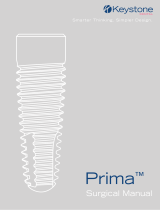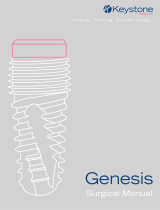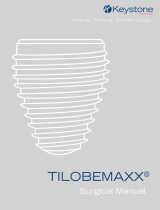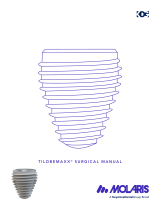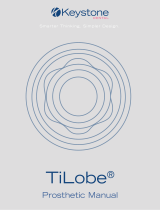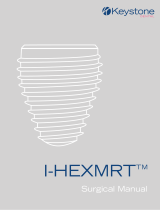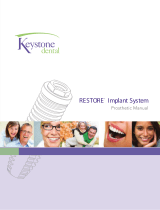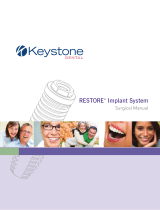Page is loading ...

Smarter Thinking. Simpler Design.
Surgical Manual
Prima Plus
™

2 3
TABLE OF CONTENTS
PRIMA PLUS
™
IMPLANT SURGICAL MANUAL
SURGERY
Prima Plus
™
Characteristics
4
Surgical Considerations
5
Prima Plus
™
Surgical Sequence
9
Depth Markings
11
Drilling Sequences
12
Product specifications are subject to change without notice.
Items illustrated are not to scale.

4 5
Design Features
The Prima Plus™ dental implant features the Ti-Lobe connection. This
internal 6-lobe connection combines the benefits of a platform switch,
internal lobed design, and integrated pilot (self-alignment feature),
providing a secure implant/abutment connection. This design allows for
one screw for all platform diameters.
Dimensions
• The Ø3.5 mm Prima Plus™ implants can be restored with
either 4.0 mm or 5.0 mm prosthetic components.
• The Ø4.1 mm Prima Plus™ implants can be restored with
either 5.0 mm or 6.0 mm prosthetic components.
• The Ø5.0/6.0 Prima Plus™ implants share the same connection
and can be restored with either a 6.0 mm prosthetic component
or a Ø7.0 and Ø8.0 mm Healing Abutment.
The Ø3.5 mm Prima Plus™ implants are available in
8.0, 10.0, 11.5, 13, 15 mm lengths.
The Ø4.1 mm Prima Plus™ implants are available in
8.0, 10.0, 11.5, 13, 15 mm lengths.
The Ø5.0 mm Prima Plus™ implants are available in
8.0, 10.0, 11.5, 13, 15 mm lengths.
The Ø6.0 mm Prima Plus™ implants are available in
8.0, 10.0, 11.5, and 13 mm lengths.
Considerations
INDICATIONS
Keystone Dental Prima Plus™ implants are intended for use in partially
or fully edentulous mandibles and maxillae, in support of single or
multiple-unit restorations including cement-retained, screw-retained, or
overdenture restorations, and terminal or intermediate abutment support
for fixed bridgework.
SPECIFIC INTENDED USES
Prima Plus™ Internal Connection Implants are threaded, internal
connection implants intended for immediate placement and can be
restored with a temporary prosthesis in single- tooth and multiple- tooth
applications with good quality bone.
CONTRAINDICATIONS
• General contraindications associated with elective surgery
should be observed
• Possible contraindications: chronic bleeding problems,
psychological impairment, metabolic bone or connective tissue
diseases, treatment with corticosteriods, certain cardiac and
vascular diseases, tobacco usage, diabetes (uncontrolled),
treatment with chemotherapeutic agents, chronic renal
disease, poor patient oral hygiene, bruxing, alcoholism
• Temporary contraindications: systemic infection; local oral or
respiratory infection
• Anatomical or pathological contraindications: insufficient
alveolar bone width and height to surround the implant with
at least one millimeter of bone, both buccally and lingually to
the most superior aspect of the implant body; inadequate bone
height where proper implant placement would encroach on the
mandibular canal; malignancies
For additional information, please consult the Keystone Dental Prima Plus
™
Implant
Instructions for Use
.
3.5
3.8
3.5
4.1
5.0
3.5 4.1
5.0
PRIMA PLUS
™
CHARACTERISTICS
SURGICAL
CONSIDERATIONS
SOFT TISSUE HEALING AND TEMPORIZATION
Following the placement of a Prima Plus™ implant, soft tissue can be
contoured using a titanium Healing Abutment or a custom fabricated
temporary abutment.
A Temporary Abutment can be placed at this time for immediate tempo-
rization. The acrylic portion of the Temporary Abutment bonds with dental
composite/acrylic allowing for custom esthetic contouring directly to the
Temporary Abutment.
PATIENT EVALUATION AND SELECTION
Successful implant treatment requires the coordinated efforts of the
implanting surgeon, the restorative dentist, and the dental laboratory
technician. Proper patient selection is important for long-term function
of a dental implant. The following factors should be considered prior to
implant surgery:
• General medical history
• Oral hygiene
• Patient’s expectations
• General dentistry and product indications and contraindications
• Anatomical landmarks related to implant positioning
• Inter-occlusal clearance (the space available between alveolar
crest and opposing dentition)
• Ridge width in relation to the implant diameter
• Emergence profile of the restoration in relation to prosthetic
platform diameters
BONE QUALITY
While one method of classifying bone density is shown in the images
below, different combinations of cortical and trabecular bone in
varying thicknesses and densities can occur. These typically differ by
jaw location. The clinician is responsible for assessing bone density of
the surgical site and choosing the appropriate protocol.
8.5˚ Taper
6-Lobe Connection
Pilot
3.5
3.8
3.5
4.1
5.0
3.5 4.1
5.0
3.5
3.8
3.5 4.1
5.0
3.5 4.1
5.0
3.5
3.8
3.5 4.1
5.0
6.0
3.5 4.1
5.0
D1 Bone
Cortical bone
D2 Bone
Cortical bone/
trabecular
D3 Bone
Cortical bone/
trabecular
D4 Bone
Cortical bone/
trabecular

6 7
Surgical Kit
The Surgical Kit must be cleaned and sterilized prior to use. For further
information, please consult Keystone Dental’s
Instructions for Use
.
• All surgical instruments are provided non-sterile.
• All Prima Plus™ drills are externally irrigated and require
external irrigation when preparing the osteotomy.
• All drills must be inspected for signs of wear, damage or
discoloration.
The drills are labeled with a diameter to facilitate proper instrument
selection. It is recommended to inspect the latch-lock shank after each use.
The number of uses per drill will vary and depends on a variety of factors
including bone density, proper handling and cleaning. It is recommended
to replace drills after 20 osteotomies, as repeated sterilizations and use
may affect cutting efficiency and depth marking appearance.
Drilling and Tapping Procedures
Soft bone considerations: The end-cutting capabilities of Prima Plus
TM
allows it to be inserted into sites that have been prepared with a reduced
diameter drill (see drilling protocol on page 12). When the implant is
inserted, the end-cutting features will aid in guiding the implant to the
final depth.
Dense bone considerations: Utilizing the end-cutting feature to seat the
implant should not be attempted in dense bone. Surgical taps should be
used when the recommended surgical protocol (see drilling protocol on
page 12) is not sufficient to fully seat the implant or insertion torques are
higher than 70Ncm.
• It is recommended to avoid lateral pressure during drilling and
tapping procedures as the resulting osteotomy may be oversized and/
or redirected.
• When using the Twist Step drills, it is recommended to use an in-and-
out technique when preparing the site. Recommended drill speeds are
1200 - 1500 rpm.
• When tapping, the top of the tap should correspond to the height of
the implant platform, regardless of implant length.
Surgical Guide
Available planning software provides both clinicians and technicians the
ability to plan implant placement three-dimensionally in conjunction with
CT scans. A surgical guide could aid in the site preparation and placement
of implants.
Implant Selection
Implant selection should be made with the final restorative result as the
primary consideration.
Selecting implants in this manner aids in maximizing biomechanical
stability and proper contouring of the soft tissue. Choosing an implant
with a slightly smaller platform than the emergence of the tooth being
replaced will provide support of the soft tissue and optimize the esthetic
result.
Implant placement and healing abutment selections should be based on
the following:
• Emergence profile of the restoration in relation to the prosthetic
platform diameter
• Height and diameter of the crown as it emerges through the
tissue
Instrument Care
Instruments must be cleaned and sterilized prior to first and after each use
based on established procedures. Proper instrument care is an important
part of successful implant dentistry.
PRE-CLEANING
• Used instruments should be soaked immediately in instrument
cleaning solution to avoid the drying of blood, saliva and tissue
residue.
• Used surgical trays including grommets must be cleaned with a
suitable disinfectant.
• Multiple-part instruments must be disassembled prior to
cleaning and sterilization.
• Internal debris/residue of instruments must be removed with a
soft brush.
• Instruments should be inspected, cleaned separately and
discarded if damaged.
PRINCIPAL CLEANING
• Best results are achieved if surgical instruments are cleaned by
material type.
• Instruments and trays can be cleaned and disinfected in a
dedicated dishwasher or alternatively by hand, followed by
an ultrasonic bath with a detergent appropriate for surgical
instruments.
• Instruments and trays must be rinsed and dried thoroughly.
STERILIZATION
Instruments and tray should be autoclaved with a sufficient drying cycle to
avoid instrument corrosion. Instruments should be placed in the tray and
wrapped in sterilization paper or sterilization packs featuring indicating
tape and date of sterilization.
• Steam Sterilization Gravity Cycle: 134˚C (~273°F)
20 minute exposure / 40 minute dry time
• Steam Sterilization Pre Vacuum Cycle: 134˚C (~273°F)
4 minute exposure / 40 minute dry time
SURGICAL MOTOR AND HANDPIECE
Cleaning and maintenance instructions for W&H handpieces and motors
can be found on www.wh.com.
SURGICAL
CONSIDERATIONS
SURGICAL
CONSIDERATIONS
(-) Denotes widening of the crestal bone is recommended.
Ø4.1 x 11.5mm

8 9
SURGICAL
CONSIDERATIONS
PRIMA PLUS
TM
SURGICAL SEQUENCE
Implant Packaging
Each Prima Plus
™
implant is packaged in a vial, sealed in a tray with a
Tyvek
®
lid and gamma-sterilized. The flip-open lid on the vial contains
a cover screw. The sealed tray contains a label identifying the implant
type, diameter and length, as well as other important device information.
Inside, pre-printed patient labels with product data and the lot number
are provided. These are adhesive labels that should be affixed to the
patient’s chart.
Opening instructions:
1. The Tyvek
®
lid on the tray is peeled back and placed into the sterile
field.
2. The patient labels are affixed to the patient’s chart.
3. The implant lid is flipped open to gain access to the selected Prima
Plus
™
implant.
The implant may now be removed from the vial, delivered to the site and
placed using one of the following options.
Implant Delivery
Prima Plus
™
implants are delivered to the osteotomy with an Implant
Driver.
The Implant Driver is aligned with the implant. While pressure is applied,
the Implant Driver is rotated at a speed less than 20 rpm until the lobes of
the Implant Driver engage the implant lobes. A tactile and/or audible click
may occur indicating the Implant Driver is engaged. The implant is lifted
out of the vial and placed into the osteotomy.
NOTE: When correctly seated, the laser mark on the driver should be below
the platform of the implant and not visible.
The Implant Driver is pulled straight up to disengage the Implant Driver
from the implant. Special care should be taken in very soft bone to not
disrupt primary stability.
Implant Placement
The final implant position is at the discretion of the surgeon. Each case
should be evaluated on the basis of placement, protocol and type of
implant prior to osteotomy preparation. It is recommended to place a
Prima Plus
™
implant at bone level.
Soft Bone
Medium Bone
Dense Bone
Surgical Sequence – Prima Plus™ Ø4.1 mm x 11.5 mm (For demonstration purposes)
For additional drilling protocols by bone density please see page 12.
NOTE: Drill dimensions in brackets
denote that widening of the
crestal bone for insertion torques
above 70Ncm is recommended.
1.8 mm Initial Drill x 11.5 mm
Drill Speed 1200-1500 rpm
1.8 mm Initial Drill x 11.5 mm
Drill Speed 1200-1500 rpm
1.8 mm Initial Drill x 11.5 mm
Drill Speed 1200-1500 rpm
Parallel Pin/Depth Gauge 11.5 mm
Parallel Pin/Depth Gauge 11.5 mm
Parallel Pin/Depth Gauge 11.5 mm
2.2/2.6 mm Twist Step Drill
Drill Speed 1200-1500 rpm
2.2/2.6 mm Twist Step Drill
Drill Speed 1200-1500 rpm
2.2/2.6 mm Twist Step Drill
Drill Speed 1200-1500 rpm
(2.6/2.9) mm Twist Step Drill
Drill Speed 1200-1500 rpm
(It is not recommended to drill
to full depth).
2.9/3.3 mm Twist Step Drill
Drill Speed 1200-1500 rpm
2.9/3.3 mm Twist Step Drill
Drill Speed 1200-1500 rpm
(3.4/3.9 mm) Twist Step Drill
Drill Speed 1200-1500 rpm
(It is not recommended to drill
to full depth).
Disengaged Engaged

10 11
PRIMA PLUS
TM
SURGICAL SEQUENCE
Ratchet Insertion -
Prima Plus
TM
The Surgical Ratchet can be used in
addition to or instead of a handpiece
to finalize the insertion of the implant
by engaging the Implant Driver into the
Ratchet with the Ratchet Adapter.
Two-Stage Surgery
In a two-stage surgery, the Cover Screw is
placed with a Quad Driver and the flap
margins are repositioned and sutured in
a tension-free manner. A radiograph is
recommended for use as a baseline of
implant-to-bone contact for future
diagnosis.
Step 6
Handpiece Insertion -
Prima Plus
TM
With the Implant Driver connected to
the handpiece, the internal lobes are
fully engaged by the Implant Driver and
carefully removed from the vial. It is then
carried to the osteotomy and inserted at
15-20 rpm.
NOTE: Depending on bone quality and osteotomy preparation, the insertion torque may vary from 20-70 Ncm.
Step 7
Single-Stage Surgery
In a single-stage surgery, the healing
abutment is placed with a Quad Driver
to help contour the soft tissue during
the healing phase. The flap margins are
positioned around the Healing Abutment
and sutured in a tension-free manner. A
radiograph is recommended for use as a
baseline of implant-to-bone contact for
future diagnosis.
PRIMA PLUS
TM
IMPLANT POSITIONING
If the treatment plan includes using anatomically- shaped abutments such as the angled or straight Esthetic Contour Abutments, the rotational position
of the implant can be adjusted at the time of placement to ensure optimal positioning of the final abutment. This will allow the restoring clinician to
take full advantage of the anatomical abutment contours and minimize the need for abutment prepping. If the clinical situation allows, adjust the final
position of the implant so that any one of the six internal connection lobes faces the buccal or facial aspect.
Prima Plus™ Drilling Sequence - 4.1 x 11.5 mm in Medium Bone
The Prima Plus
™
Twist Step drills feature the following laser markings:
• Laser mark represents implant length + over drill length
• Diameter and length of drill is identified on the shaft
The actual drill tip is not included in the designated drill length and must be considered when preparing the osteotomy.
PRIMA PLUS
™
DEPTH MARKINGS
1.8 x 11.5 mm
Initial Drill
Parallel Pin/
Depth Gauge
2.2/2.6 x 11.5 mm
Twist Step Drill
Implant
Length
Bone Level
Over Dril Depth
15 mm
13 mm
11.5 mm
10 mm
8 mm
2.9/3.3 x 11.5 mm
Twist Step Drill
Prima Plus
TM
Implant
Twist Step Drills Over Drill Depth
Ø3.5 mm 0.88 mm
Ø4.1 mm 0.83 mm
Ø5.0 mm 1.03 mm
Ø6.0 mm 1.13 mm
Over Drill Depth
Bone Level 11.5 mm
13 mm
15 mm
8 mm
10 mm

12 13
Drill protocols are based on bone quality. Drill dimensions in brackets denote that widening of the crestal bone for insertion
torques above 70Ncm is recommended.
DRILL
SEQUENCE
PRIMA PLUS
™
DRILLING SEQUENCE
Implant Ø (mm)
Soft Bone
Type IV
Medium Bone
Type II - III
Dense Bone
Type I
SD
3.5
1+(2) 1+2+(3) 1+2+3+(4)
RD
4.1
1+2+(3) 1+2+4 1+2+4+(5)
WD
5.0
1+2+4+5 1+2+4+6 1+2+4+6+(7)
WD
6.0
1+2+4+5+(8) 1+2+4+5+7+(8) 1+2+4+6+7+8+(9)
Implant Ø (mm)
Soft Bone
Type IV
Medium Bone
Type II - III
Dense Bone
Type I
SD
3.5
1.8 1.8 1.8
(2.2/2.6) 2.2/2.6 2.2/2.6
(2.6/2.9) 2.6/2.9
(2.9/3.3)
RD
4.1
1.8 1.8 1.8
2.2/2.6 2.2/2.6 2.2/2.6
(2.6/2.9) 2.9/3.3 2.9/3.3
(3.4/3.9)
WD
5.0
1.8 1.8 1.8
2.2/2.6 2.2/2.6 2.2/2.6
2.9/3.3 2.9/3.3 2.9/3.3
3.4/3.9 3.8/4.1 3.8/4.1
(4.4/4.8)
WD
6.0
1.8 1.8 1.8
2.2/2.6 2.2/2.6 2.2/2.6
2.9/3.3 2.9/3.3 2.9/3.3
3.4/3.9 3.4/3.9 3.8/4.1
(4.6/5.3) 4.4/4.8 4.4/4.8
(4.6/5.3) 4.6/5.3
(5.3/5.7)

Keystone Dental, Inc.
Global Headquarters
154 Middlesex Turnpike
Burlington, MA 01803 USA
General Inquiries: 781-328-3600
Customer Relations: 866-902-9272 or 781-328-3490
Fax: 866-903-9272 or 781-328-3400
Email: [email protected]
Keystone Dental, Inc.
5 Holland, Building 209
Irvine, CA 92618 USA
EMERGO Europe B.V.
Prinsessgracht 20
2514 AP The Hague
The Netherlands
Caution, consult accompanying documents
Trademark Acknowledgements
Prima Plus
TM
, “Smarter Thinking. Simpler Design.” and TiLobe are trademarks and registered
trademarks of Keystone Dental, Inc.
©2017 Keystone Dental, Inc.
100045-EN01 REV A 11/2017
Smarter Thinking. Simpler Design.
0086
/
